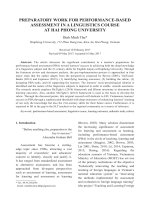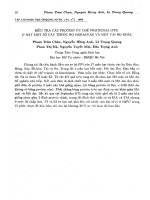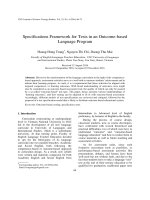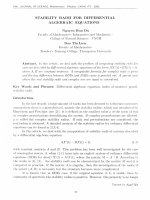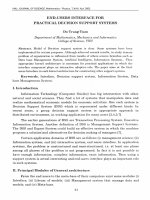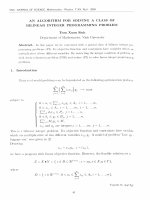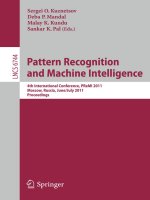DSpace at VNU: End-users interface for pratical decision support systems
Bạn đang xem bản rút gọn của tài liệu. Xem và tải ngay bản đầy đủ của tài liệu tại đây (3.28 MB, 9 trang )
VNU. JOURNAL OF SCIENCE, Mathematics - Phystcs, T.XV1II, N q4, 2002
E N D -U S E R S IN T E R F A C E F O R
P R A C T IC A L D E C IS IO N S U P P O R T S Y S T E M S
Do Trung Tuan
D e p a rtm e n t o f M a t h e m a t ic s M e c h a n ic s a n d In f o r m a t ic s
C o lle g e o f S c ie n c e , V N U
Abstract. Model of Decision support system is clear. Some systems have been
implemented for certain purposes. Although achieved remark results, in study domain
problem of organization is influenced from results of others science branches such as
Data base Management System, Artificial Intelligent, Information Systems... Then
appropriate kernel architecture is necessary for practical applications in which the
interface component plays an interactive adaptive role. The paper aims at the Endusers Interface in such kernel architecture for constructing other support, systems.
K e y w o rd s. Interface, Decision support system, Inform ation System, Data
base Management System.
I. Introduction
Inform ation Technology (Computer Science) has big intersection with other
natural and social sciences. They find a lot of systems that m anipulate data and
realize m athem atical economic models for economic activities. One such system is
Decision Support System (DSS) which is represented under different kinds. In
recent years, a group decision support system is appropriate approach in
distributed environm ent, in working application for many users [2,4,5,7],
The earlie r generations of DSS are Transaction Processing System, Executive
Inform ation System. Another definition of DSS is Management Support Systems.
The DSS and Expert System could build an effective system in which the machine
proposes a solution and alternatives for decision making of managers [7].
Certain application domains of DSS are as follows (i) management science; (ii)
Inform ation system; and (iii) interactive system, end users interface. In application
systems, the problem is unstructured and sem i-structured, i.e. at least one phase
among a ll phases of the problem is not programmed. In fact it is not possible to
have enough inform ation, complete information, exact information. Then using a
support system is actual interesting and e n d - u s e rs in te rfa c e plays an im portant role
in such systems.
II. Principal Modules of General architecture
From the end users to the meta-base of their computers exist some modules (i)
Interface; (ii) Lib rary of models; (iii) Management system that manage data and
models; and (iv) Meta-base.
44
End-uscr interface for practical decision support systems
45
II. 1. I n t e r fa c e m a n - m a c h i n e
For our opinion, the interactive end users interface is the most important
because of its effectiveness on whole system. In this year, a m ultim edia interface is
suitable. A multimodal approach w ill be developed at next generation of software.
In parallel, an oral interface is better, but it requires special equipments of sound
processing. Although there are many kinds of 4th generation language, the
interface command-response is appreciate in actual systems.
11.2. L i b r a i y o f m o d e ls
Models such as economic models, mathematical economic models are stored in
the base for being called when needed. G enerally they are routines which
correspond to models of data processing. The system manage them by their
identifier and parameters. Inform ation exchanged may be presented under
messages between system modules. W ith such design, users can add/ delete/ update
total models or a part of them.
In the DSS models play a role of an alternative method of data processing that
permit the interface to present an other available solution. Embedding the lib rary
in the Management System is hard for designers. Problems concerning the models
in DSS were found in [1,4,7].
U sers
F ig u r e 1. A general architecture of DSS
IL3. M e ta -b a se
Norm ally a data base is build for at least quantitative m anipulation. By the
data base, the support systems can realize qualitative, but more difficult and no
transparent. However using rules and facts are ready on recent system. A
knowledge base is necessary for accum ulating and m anipulating expert's advise. On
a data base management system it is able to extent data to knowledge. A speudoRelational Model could be proposed actually and further an Object-oriented Model
is more appreciated.
Do Trung T u a n
46
11.4. M a n a g e m e n t s y s te m
Beside the function of data m anipulation (inpuư retrieve/ update/ print), the
Management System must be developed to motor engine. Whereas the system is not
an Expert System, a mechanism of rule/ fact m anipulation is demanded. Control on
models is responsible to message m anipulation.
11.5. P r o p o s a l o f a k e r n e l a r c h ite c tu r e
After some rem arks about DSS and its components, after certain results of
Turban from [7], of Sprague et al. from [2,3], we proposed a kernel architecture for
a practical DSS. In order to implement such architecture, the modules are written
separately. They exchange inform ation by messages. Programming language is
either c language or Assembly for professional programmers. Furtherm ore certain
tools permit the users to customize the interface and split the big problem into
sm aller ones.
Concerning the end user interface, the kernel architecture composed of cither
the e n d u s e rs in te rfa c e a n d the m a n a g e m e n t system or the o n ly m a n a g e m e n t sy s te m .
The later approach attempts a complete interface with different kinds of command
languages. In this paragraph, the Kernel Architecture indicates the Management
System. It is a accelerated Database Management System based on Relational
Model.
Functions of data m anipulation are discussed. It is not new idea :
1. Entry data by data file, forms... from screen or secondary memory.
Interactive mode is used. The users present their question under form of
SQL command.
2. Retrieve by criteria on attributes of entities. AND qualification norm is
used for questions.
3. Update data : inserting, deleting record and modifying data item. These
actions are popular in tables of Relational Model.
4. Change data structure : inserting / deleting attributes of relational table
and extent user's view.
Other problem having to solve is one hand knowledge representation and
other hand model management. The later is satisfied with assistance of message
management. A message header, name of routine, parameters are elements of the
message.
F ig u r e 2. Message for model management
End-user interface for practical decision support systems
47
Knowledge noted here is rule. Because of the capacity of management system
in rule/ fact m anipulating, rules are simple and related to certain domains. A
relational table for rules has two columns (attributes) : IF part and TH EN part. The
end users consider these rules as records (n-tuples) of relational table. It depends
on the treatm ent way to fire the rules. The IF clause is considered criteria in which
system status can be satisfied. A simple form is as qualifier in user's question. The
TH EN clause is various : determining variable value, exiting to call routine,
changing system status... A appropriate strategy to control rules is necessary since
the system needs an enough strategy rather than complete one. A simple using of
the back chaining, forward chaining techniques in expert system is better.
III. End-users interface
For a m ulti-purposes practical DSS, we proposed the architecture presented in
previous paragraph. An end user interface is worth most interested by following
reasons :
Allow ing non*informaticians to access to the support systems;
Introducing advanced technologies, especially m ultim edia and multimodal
tools;
Independencies in DSS, in despite of the interface module is in/ out the
management system of DSS.
IIL1. I n t e r f a c e m a n a g e m e n t sy ste m s
An indepedent module with the function as “Interface Management System” is
useful in applications with dynamic data where interface builders fail, are really
usable for end-users. This rem ark is same the conclusion in the DSS Interfaces
Meeting organized at June 13, 2001 [3]. Such module composed some components
for
Functional processes, w ithin the DSS capabilities/ constraints;
Transactional interface formats, with emphasis on balance-affecting
transactions; and
Data to be exchanged, in order to ensure specific data element values were
m eaningful to both DSS and the components asset management system.
Furtherm ore the interface module is responsible for methods, tools, and
techniques for developing the overt user interface of a DSS; managing linguistic,
presentation, and user knowledge in a DSS; DSS help facilities; coordinating a
DSS's interface events with its functionality events.
Do Trung T u a n
48
U sers
j□
:□
:□
Functional p ro c e sse s
Transactional interface form ats
Data exchange
;!
~
Ii
7
~
T
T
........
;
O S S M a n a g e m e n t S y s te m
( g e n e r a l d a ta m a n a g e m e n t)
F ig u r e 3. Interface management system in DSS architecture
IIL 2. Sorne a s p e c ts o f D S S ’s i n te r f a c e
For developing the interface management system, we proposed some aspects of
the system that w ill be respected. Certain aspects were found from Sauter in [2,6].
1. P o r t a b le : interface code should be portable, i.e. there should be a way to
compile the same code for different host systems such that different look and feels
of different platform s can be supported;
2.
M a t c h in g
the
n e e d s o f u s e rs : for commercial application, it is most
im portant to exactly match the look and feel and to exploit the most recent features
of the host system. Another dim ension to be considered is the way, interfaces are
specified: with (i) direct-m anipulative interface builders or with (ii) languages that
support high-level program ming abstractions. Sauter [6] referenced to the research
area of user interface management systems in a lot of different systems and
approaches, such as of Foley et al. or of Myers.
the facilities are named “Interactive Interface
Builders”. It seems that the facilities were the best way to construct the DSS
interface by interactive graphical m anner or by graphical prototypes. Detailed in
constructing a DSS interface, it must focus on:
3.
C u stom ize facilities:
L ib r a r ie s for standardized dialog objects like buttons, list-gadgets, text-
gadgets, gauges that can be interactively composed inside a dialog
window. Simple form-based interfaces can be built with minimum effort.
However, when more flexib ility is needed, there are some problems with
th is approach.
G r a p h ic a l o b je c ts allows the system designer to build (i) special "actions"
are predefined for graphical objects; (ii) actions are realized as generic
functions using of host systems; and (iii) additional specific actions can be
declared and application-specific methods can be w ritten for predefined
actions. The la y o u t of the items inside a dialog window must be adapted
End-uscr interface for practical decision support systems
49
when the window is resized. User interface management systems manage
pane layout by inserting special panes (layout manager panes) into the
pane hierarchy.
Interface development involves more than interface builders currently
support. P r o g r a m m in g is still required for serious applications.
F ig u r e 4. Some aspects concerning to constructing a DSS interface
: Model-based interface tools supply
explicit models of how an interface should look and behave. Certain aspect
concerning (i) Application semantics: objects and operations of the domain
of discourse; (ii) Presentation templates: visu al appearance of an interface
defined by widgets (line, icon, text, menu, button, column, row, table,
graph); (iii) Behavior: input gestures to be applied to presented objects for
specialized interaction styles; (iv) Dialog sequencing: ordering constraints
for commands; and (v) Action side-effects: actions executed automatically
after a command (e.g. making a new object the "current” object). Designers
prepare knowledge for the functions such as (i) to model attributes of
graphical objects; (ii) possible actions defined on them. One goal of the
model is to use explicit models to map low-level user gestures onto highlevel semantics embodied in the design models and to generate automated
(and animated) help facilities.
T o o ls f o r M o d e l-b a s e d In t e rfa c e
U s in g a b s tra c t f a c ilit ie s : Abstractions used to model applications and
interfaces being introduced by various user interface management systems
are quite sim ilar. However, they differ in th eir concrete environment.
III.3. I n t e l l i g e n t U ser I n t e r fa c e s
The area of intelligent user interfaces covers a variety of topics concerned
with the application of A rtificia l Intelligence and knowledge-based techniques to
issues of Human-computer Interaction.
Do Trung T u a n
50
S u * User requirements
(constraints)
ah
0 .= >
r e q u ir e m e n t
m a n ip u la tio n
P ro g ra m e d
m odun
W haM f
Meta base
U s e r m o d e llin g ( c o n c e r n in g u s e r m o d e l,
p s y c h o lo g y m o d e l, c o g n it iv e m o d e l...)
F ig u r e 5. Solution for Intelligent user interface
The design of effective and efficient Human-computer Interfaces becomes ever
more critical to overall system performance. Advanced applications are
characterized by large amounts of inform ation to be conveyed and understood,
complex task structures, real-tim e performance characteristics, and incorporation of
autonomous or semiautonomous agents. The requirem ents imposed by Humancomputer Interaction with such systems exceed the capabilities of conventional
interfaces which often fail to reflect the semantics of its users’ tasks and problem
domain properly. Intelligent user interfaces aim to cope with these serious semantic
problems and help users to access inform ation or solve complex tasks by being
sensitive to a user’s knowledge, misconceptions, goals, and plans.
A beginning version of intelligent interface is programmed module, but later
versions can adapt the users need, then propose an appropriate solution based on
knowledge in the meta base and user information.
I I I .4. U ser m o d e l i n g
informatician
Actual information
User requirements
(constraints)
T ec h n iq u e for
ac q u isitio n
¥
U ser m odelling
¥
Meta base
F ig u r e 6 . Acquisition of user requirem ent for user modeling
For user oriented approach in designing DSS’s interface, an user modeling is a
solution. The internal and communicative behaviour of an interactive computer
system is affected by its knowledge about the user to DSS. The knowledge may be
im plicit in the design of the system, or explicitly available. User-adapted
End-uscr interface for practical decision support systems
51
interaction requires the use of an explicit model of the user, i.e., the knowledge
about the user must be explicitly represented and modifiable, and the system has to
contain mechanisms to exploit this explicit information to adapt its behaviour to
specific users dynam ically. A user model is a knowledge source which contains
explicit assum ptions on a ll aspects of the user that may be relevant for the
behaviour of the system.
III. 5. P r o p o s a l o f E n d - u s e r s in te r f a c e
For our experiments, following procedure is acceptable :
Procedure for constructing an End-users interface in the practical DSS
The procedure im plicates the existence of Data Management System in which
da ta and knowledge is manipulaed.
Step 1. A nalysing the users requirements
Preparing tools for surveys to users;
Acquisition of users' needs;
Analysing the requirements.
Step 2. Designing End-users interface
Using “Interactive Interface Builders”, norm ally graphical and interactive
tools;
Proposal of End-users interface;
Evaluation.
Step 3. Transfering the Interface Specification to Data Management System
Co-ordinating the interface specification to the Data Management System;
Evaluation and interface tunning.
Step 4. Access to the Data Management System (requests from End-users
interface to the Kernel system)
Step 5. F in al evaluation (For accepting the solution of End-users interface).
rv. Conclusion remark
For sem i-structure/ non-structure application, DSS is prefered. In the first
international conference on DSS organized 1984 in Paris, end user interface was
determined as an im portant component in DSS architecture.
In practical multi purposes in order to introducing support systems rather
than general information systems, the end user interface plays the dynamic role
and is worth to become an independent one. The interface management system
Do Trung T ua n
52
proposed in this paper is just principal frame, must be detailed for concrete
application.
In fact a beautiful architecture is good for presenting, but sm all simple
implementation is acceptable, especially for lower level of industrialization. A DSS
can be based on spread sheet as LOTUS 123 and meets user's need. Although in
order to develop a bigger system, a kernel proposition is interesting.
REFEREN CES
1.
Bianchi-Berthouze N., An interactive environm ent for kansei data mining, 2nd
in t e n a t io n a l w o rk s h o p on m u lt im e d ia d a ta m in in g , August 26th 2001,
Sanfrancisco, CA, USA, p 58-67.
2.
Brobst S., Rarey J., Five stages of data warehouse decision support evolution,
T e ra n d a m a g a z in e , Spring, NCR corporation, 2001.
3.
Reid, c., Decision support systems, h t t p :I / w w w .e ls e v ie r .c o m /in c a / p u b lic a t io n .
2000.
4.
Sprague, R.H., D e c is io n S u p p o r t S y s te m , p u t t in g th e o ry in to p r a c t ic e , Ed.
Prentice H all, 1989.
5.
Sprague H., Carlson E. D., B u il d in g E ff e c t iv e D e c is io n S u p p o rt S ystem s.
E n g le w o o d C l if f s , N .J.,Prentice-H all, Inc.: 1982.
6.
Sauter, V. L., D e c is io n s u p p o r t s y s te m s , Chapter 5 : users interface components
DSS lin ks, h ttp .'f / u m s l.e d u s 1999.
7.
Turban, E., D e c is io n s u p p o r t sy ste m s a n d E x p e r t s y s te m s > 4th ed., Ed.
PrenticeH all, 1996.

